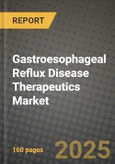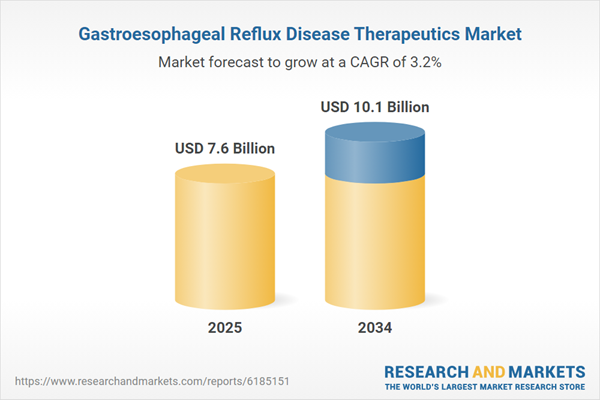Gastroesophageal Reflux Disease Therapeutics Market Overview
The Gastroesophageal Reflux Disease (GERD) Therapeutics Market is witnessing significant growth as the prevalence of acid reflux and related digestive disorders continues to rise globally. GERD is a chronic condition characterized by acid reflux from the stomach into the esophagus, causing symptoms such as heartburn, regurgitation, and discomfort. The increasing incidence of GERD is linked to changing dietary habits, sedentary lifestyles, obesity, and an aging population. The market for GERD therapeutics includes proton pump inhibitors (PPIs), H2-receptor antagonists, antacids, prokinetics, and surgical interventions for severe cases. Pharmaceutical companies are focused on developing more effective, long-lasting, and minimally invasive treatment options to address patient needs. With growing awareness about GERD and its potential complications, such as Barrett’s esophagus and esophageal cancer, demand for effective therapeutics is on the rise. The market is also witnessing innovations in drug formulations and delivery mechanisms to improve patient compliance and treatment outcomes. As research into gastroesophageal diseases advances, newer therapies targeting the underlying causes of GERD are expected to expand treatment options and drive market growth.The GERD therapeutics market has seen notable advancements, particularly in the development of novel drug formulations and non-invasive treatment approaches. Pharmaceutical companies have introduced innovative proton pump inhibitors with enhanced efficacy and longer-lasting acid suppression effects. Additionally, research into potassium-competitive acid blockers (P-CABs) has gained traction as an alternative to traditional PPIs, offering faster relief and fewer side effects. The market has also seen an increasing focus on combination therapies, where drugs with different mechanisms of action are being used together to improve treatment outcomes. Furthermore, the growing adoption of minimally invasive procedures, such as magnetic sphincter augmentation (MSA) and endoscopic therapies, is providing new treatment alternatives for patients with severe or refractory GERD. Regulatory approvals for advanced therapeutics and growing investments in gastroenterology research have contributed to expanding the market. However, concerns over long-term PPI use, including risks of kidney disease and nutrient malabsorption, have led to increased patient preference for alternative treatments, such as lifestyle modifications and complementary medicine.
The GERD therapeutics market is expected to continue evolving with the introduction of precision medicine approaches and biologic therapies targeting underlying causes of reflux disease. The increasing use of artificial intelligence and big data in gastroenterology is anticipated to enhance disease diagnosis, personalized treatment plans, and patient monitoring. With ongoing research into gut microbiome interactions, future therapeutics may focus on microbiome-modulating therapies to address GERD from a holistic perspective. Additionally, non-drug solutions, such as neurostimulation devices and robotic-assisted surgical procedures, are expected to gain traction as alternatives to conventional medications. The market will also benefit from the expansion of telemedicine services, allowing for better disease management and access to specialized care. Emerging markets, particularly in Asia-Pacific and Latin America, will present lucrative growth opportunities due to increasing healthcare awareness and access to modern medical treatments. As pharmaceutical and medical device companies continue to invest in innovation, the GERD therapeutics market is poised for sustained expansion, offering more effective and patient-friendly solutions for acid reflux management.
Key Insights: Gastroesophageal Reflux Disease Therapeutics Market
- Rise of Potassium-Competitive Acid Blockers (P-CABs): P-CABs are gaining popularity as a faster and more effective alternative to proton pump inhibitors, offering better acid suppression with fewer side effects.
- Growth of Non-Invasive Treatment Methods: Endoscopic and device-based therapies, such as magnetic sphincter augmentation and transoral incisionless fundoplication, are becoming viable alternatives to long-term drug use.
- Expansion of Combination Therapy Approaches: The use of dual therapy combinations, such as PPIs with prokinetics or mucosal protectants, is improving treatment effectiveness and patient outcomes.
- Integration of AI and Digital Health Solutions: AI-driven diagnostics, telemedicine consultations, and mobile health applications are enhancing GERD patient management and treatment adherence.
- Microbiome Research in GERD Treatment: Studies on gut microbiota are leading to the development of probiotic-based and microbiome-targeted therapies to address acid reflux at a systemic level.
- Rising Prevalence of GERD and Related Disorders: Increasing cases of acid reflux, obesity, and poor dietary habits are driving the demand for effective GERD treatments worldwide.
- Advancements in Drug Development and Novel Therapies: Pharmaceutical research is leading to improved drug formulations, alternative acid blockers, and combination therapies for better disease management.
- Increasing Adoption of Minimally Invasive Procedures: The growing preference for non-surgical treatment options, such as endoscopic interventions, is expanding therapeutic choices for GERD patients.
- Expanding Healthcare Access in Emerging Markets: Improved healthcare infrastructure and awareness in developing regions are increasing the adoption of GERD medications and treatment solutions.
- Concerns Over Long-Term PPI Use and Safety Risks: Studies linking prolonged proton pump inhibitor use to kidney disease, osteoporosis, and nutritional deficiencies have led to growing concerns and a shift toward alternative therapies.
Gastroesophageal Reflux Disease Therapeutics Market Segmentation
By Type
- Branded
- Generic
By Drug Class
- Antacids
- Proton Pump Inhibitors
- Histamine Blockers
- Pro-Kinetic Agents
- Other Drugs Class
By Distribution Channel
- Hospital Pharmacy
- Drug Stores
- General Stores
- Supermarkets
By Application
- Crohn’s Disease
- Gastroesophageal Reflux Disease (GERD)
- Ulcerative Colitis
Key Companies Analysed
- Pfizer Inc.
- Johnson and Johnson
- Novartis AG
- Sanofi S.A.
- AstraZeneca plc
- Medtronic PLC
- GlaxoSmithKline plc
- Eisai Co. Ltd.
- Takeda Pharmaceutical Company Limited
- bioMerieux SA
- Teva Pharmaceutical Industries
- Dr. Reddy's Laboratories Ltd.
- Bruker Corp
- Amneal Pharmaceuticals LLC
- CHEPLAPHARM Arzneimittel GmbH
- Daewoong Pharmaceutical Co. Ltd
- Ironwood Pharmaceuticals Inc.
- Sebela Pharmaceuticals Inc.
- Camber Pharmaceuticals Inc.
- Sun Pharmaceutical Industries Ltd.
- EndoGastric Solutions
- RaQualia Pharma Inc
- TWi Pharmaceuticals Inc.
- Astellas Pharma Inc.
- SFJ Pharmaceuticals Group
- Boehringer Ingelheim International GmbH
- Cadila Pharmaceuticals Limited
- Addex Pharmacetuicals.
Gastroesophageal Reflux Disease Therapeutics Market Analytics
The report employs rigorous tools, including Porter’s Five Forces, value chain mapping, and scenario-based modeling, to assess supply-demand dynamics. Cross-sector influences from parent, derived, and substitute markets are evaluated to identify risks and opportunities. Trade and pricing analytics provide an up-to-date view of international flows, including leading exporters, importers, and regional price trends.Macroeconomic indicators, policy frameworks such as carbon pricing and energy security strategies, and evolving consumer behavior are considered in forecasting scenarios. Recent deal flows, partnerships, and technology innovations are incorporated to assess their impact on future market performance.
Gastroesophageal Reflux Disease Therapeutics Market Competitive Intelligence
The competitive landscape is mapped through proprietary frameworks, profiling leading companies with details on business models, product portfolios, financial performance, and strategic initiatives. Key developments such as mergers & acquisitions, technology collaborations, investment inflows, and regional expansions are analyzed for their competitive impact. The report also identifies emerging players and innovative startups contributing to market disruption.Regional insights highlight the most promising investment destinations, regulatory landscapes, and evolving partnerships across energy and industrial corridors.
Countries Covered
- North America - Gastroesophageal Reflux Disease Therapeutics market data and outlook to 2034
- United States
- Canada
- Mexico
- Europe - Gastroesophageal Reflux Disease Therapeutics market data and outlook to 2034
- Germany
- United Kingdom
- France
- Italy
- Spain
- BeNeLux
- Russia
- Sweden
- Asia-Pacific - Gastroesophageal Reflux Disease Therapeutics market data and outlook to 2034
- China
- Japan
- India
- South Korea
- Australia
- Indonesia
- Malaysia
- Vietnam
- Middle East and Africa - Gastroesophageal Reflux Disease Therapeutics market data and outlook to 2034
- Saudi Arabia
- South Africa
- Iran
- UAE
- Egypt
- South and Central America - Gastroesophageal Reflux Disease Therapeutics market data and outlook to 2034
- Brazil
- Argentina
- Chile
- Peru
Research Methodology
This study combines primary inputs from industry experts across the Gastroesophageal Reflux Disease Therapeutics value chain with secondary data from associations, government publications, trade databases, and company disclosures. Proprietary modeling techniques, including data triangulation, statistical correlation, and scenario planning, are applied to deliver reliable market sizing and forecasting.Key Questions Addressed
- What is the current and forecast market size of the Gastroesophageal Reflux Disease Therapeutics industry at global, regional, and country levels?
- Which types, applications, and technologies present the highest growth potential?
- How are supply chains adapting to geopolitical and economic shocks?
- What role do policy frameworks, trade flows, and sustainability targets play in shaping demand?
- Who are the leading players, and how are their strategies evolving in the face of global uncertainty?
- Which regional “hotspots” and customer segments will outpace the market, and what go-to-market and partnership models best support entry and expansion?
- Where are the most investable opportunities - across technology roadmaps, sustainability-linked innovation, and M&A - and what is the best segment to invest over the next 3-5 years?
Your Key Takeaways from the Gastroesophageal Reflux Disease Therapeutics Market Report
- Global Gastroesophageal Reflux Disease Therapeutics market size and growth projections (CAGR), 2024-2034
- Impact of Russia-Ukraine, Israel-Palestine, and Hamas conflicts on Gastroesophageal Reflux Disease Therapeutics trade, costs, and supply chains
- Gastroesophageal Reflux Disease Therapeutics market size, share, and outlook across 5 regions and 27 countries, 2023-2034
- Gastroesophageal Reflux Disease Therapeutics market size, CAGR, and market share of key products, applications, and end-user verticals, 2023-2034
- Short- and long-term Gastroesophageal Reflux Disease Therapeutics market trends, drivers, restraints, and opportunities
- Porter’s Five Forces analysis, technological developments, and Gastroesophageal Reflux Disease Therapeutics supply chain analysis
- Gastroesophageal Reflux Disease Therapeutics trade analysis, Gastroesophageal Reflux Disease Therapeutics market price analysis, and Gastroesophageal Reflux Disease Therapeutics supply/demand dynamics
- Profiles of 5 leading companies - overview, key strategies, financials, and products
- Latest Gastroesophageal Reflux Disease Therapeutics market news and developments
Additional Support
With the purchase of this report, you will receive:- An updated PDF report and an MS Excel data workbook containing all market tables and figures for easy analysis.
- 7-day post-sale analyst support for clarifications and in-scope supplementary data, ensuring the deliverable aligns precisely with your requirements.
- Complimentary report update to incorporate the latest available data and the impact of recent market developments.
This product will be delivered within 1-3 business days.
Table of Contents
Companies Mentioned
- Pfizer Inc.
- Johnson and Johnson
- Novartis AG
- Sanofi S.A.
- AstraZeneca PLC
- Medtronic PLC
- GlaxoSmithKline PLC
- Eisai Co. Ltd.
- Takeda Pharmaceutical Company Limited
- bioMerieux SA
- Teva Pharmaceutical Industries
- Dr. Reddy's Laboratories Ltd.
- Bruker Corp
- Amneal Pharmaceuticals LLC
- CHEPLAPHARM Arzneimittel GmbH
- Daewoong Pharmaceutical Co. Ltd.
- Ironwood Pharmaceuticals Inc.
- Sebela Pharmaceuticals Inc.
- Camber Pharmaceuticals Inc.
- Sun Pharmaceutical Industries Ltd.
- EndoGastric Solutions
- RaQualia Pharma Inc.
- TWi Pharmaceuticals Inc.
- Astellas Pharma Inc.
- SFJ Pharmaceuticals Group
- Boehringer Ingelheim International GmbH
- Cadila Pharmaceuticals Limited
- Addex Pharmacetuicals.
Table Information
| Report Attribute | Details |
|---|---|
| No. of Pages | 160 |
| Published | October 2025 |
| Forecast Period | 2025 - 2034 |
| Estimated Market Value ( USD | $ 7.6 Billion |
| Forecasted Market Value ( USD | $ 10.1 Billion |
| Compound Annual Growth Rate | 3.2% |
| Regions Covered | Global |
| No. of Companies Mentioned | 28 |









